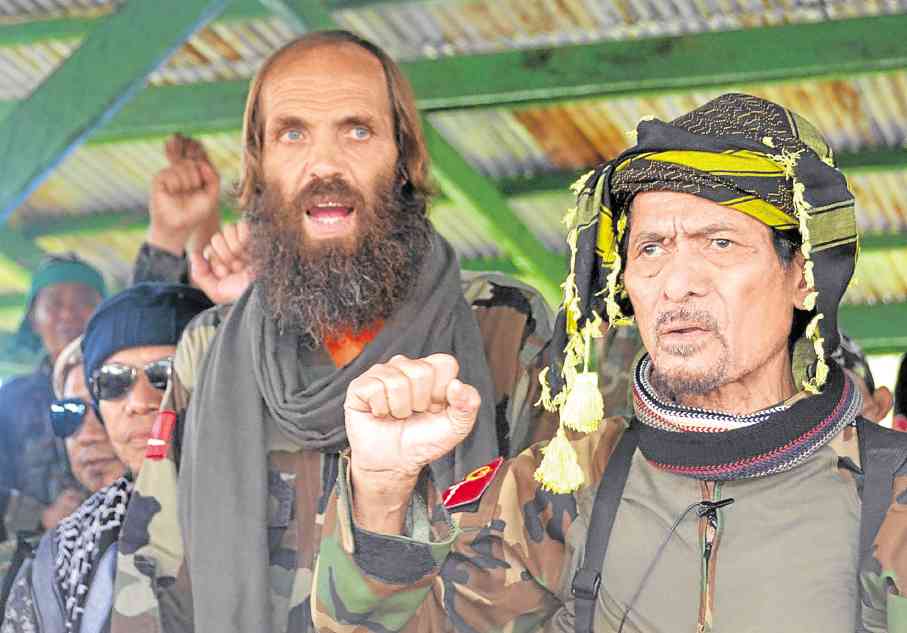
TURNOVER Norwegian hostage Kjartan Sekkingstad is turned over to Nur Misuari, leader of the Moro National Liberation Front, by the Abu Sayyaf in Indanan town in Sulu province. AP
INDANAN, Sulu—A freed Norwegian hostage on Sunday said he was “lucky to be alive” after he was kidnapped by Abu Sayyaf bandits and held in the jungles of Sulu for more than a year.
Kjartan Sekkingstad appeared gaunt and frail as he was handed over to Presidential Adviser on the Peace Process Jesus Dureza along with three Indonesian fishermen who had been held captive with him.
“I am so very happy and lucky to be alive,” Sekkingstad, heavily bearded and wearing a camouflage jacket, told reporters in Indanan town on Jolo island before being flown to Davao City to meet President Duterte.
Sekkingstad and the fishermen were turned over by the Abu Sayyaf to Nur Misuari, leader of a faction of the Moro National Liberation Front (MNLF) that has signed a peace agreement with the government, at the MNLF camp in Indanan on Saturday night.
Misuari handed over the freed captives to Dureza in Indanan on Sunday.
At his meeting with Sekkingstad in Davao City late on Sunday, President Duterte thanked Dureza, Misuari and former Sulu Gov. Abdusakur Tan for working hard for the release of the Norwegian.
To Sekkingstad, Mr. Duterte said: “Your travails in life are over.”
Sekkingstad thanked Mr. Duterte, Dureza, Misuari and the Norwegian government for working for his release.
“I am happy to be alive and free. This is a beautiful feeling,” Sekkingstad told reporters later.
Norwegian Ambassador to the Philippines Erik Forner, who was also at the meeting, thanked Mr. Duterte for Sekkingstad’s release.
“The President’s personal commitment even before he took office has been crucial to solve this issue,” Forner said.
Forner also thanked Dureza for his “tireless efforts” to get Sekkingstad released.
At the news conference in Zamboanga, Sekkingstad described his yearlong ordeal as “devastating.”
He carried a backpack with a bullet hole as a reminder of a near-death experience that included the beheadings of the two Canadians kidnapped with him.
Aside from the horror of constantly being warned he would be the next to be beheaded by the brutal extremists, Sekkingstad said he survived more than a dozen clashes between government forces and his captors in the lush jungles on Jolo Island.
In one intense battle, in which government troops opened fire from assault helicopters and from the ground, he said he felt a thud in his back and thought he was hit by gunfire.
After the fighting eased, he discovered that he wasn’t hit, and that his green, military-style backpack had been pierced by the gunfire instead.
“Devastating, devastating,” Sekkingstad, clad in a rebel camouflage uniform and muddy combat boots, said when asked how he would describe the horrific experience.
Dureza accompanied the Norwegian on a flight to Davao, where the freed hostage was to meet President Duterte.
Sekkingstad was kidnapped from a yacht club he helped managed on Samal Island, Davao del Norte province, on Sept. 21 last year, along with Canadians John Ridsdel and Robert Hall and Hall’s Filipino girlfriend, Marites Flor, sparking a massive land and sea search by government forces.
Canadians beheaded
The Abu Sayyaf demanded a huge ransom for the release of the foreigners, and released videos in which they threatened the captives in a jungle clearing where they displayed black flags similar to the standard of the Islamic State jihadi group in Iraq and Syria.
Ridsdel was beheaded in April and Hall was decapitated in June after ransom deadlines lapsed.
When Flor was freed in June, she recounted in horror how the militants rejoiced while watching the beheadings.
Sekkingstad said he and his fellow captives were forced to carry the militants’ belongings and were kept in the dark on what was happening around them.
At one point, he said, their heavily armed captors numbered more than 300.
“We were treated like slaves,” he said.
After the bandits decapitated Ridsdel, Sekkingstad was threatened by his captors, who repeatedly told him, “You’re next.”
When the negotiations for his release began in recent months, Sekkingstad said the rebels began treating him better.
It was not immediately clear whether Sekkingstad had been ransomed off.
Mr. Duterte suggested at a news conference last month that P50 million had been paid to the bandits, but that they continued to hold on to him.
The military on Saturday said relentless assaults forced the extremists to release the hostage.
Bandits got ransom
But there were reports that P20 million was paid for the release of the Indonesian sailors and P30 million for Sekkingstad’s freedom.
Heavy rains prevented Misuari’s rebel group from immediately turning over Sekkingstad to Dureza on Saturday.
The freed hostage stayed overnight in Misuari’s rebel camp, where he was given clothes with the rebel group’s insignia.
In Norway, Prime Minister Erna Solberg confirmed that Sekkingstad had been “brought to safety” after his release.
Solberg said the Norwegian foreign ministry, police and diplomats “have done a great deal of work” to have Sekkingstad released, and thanked Mr. Duterte and Dureza.
In a statement posted on the Norwegian government website, Solberg said Norway supported the Philippines “in their fight against terrorism and for peaceful outcome in the south” of the country. Reports from AP; Nestor Corrales, Inquirer.net; and Germelina Lacorte, Inquirer Mindanao